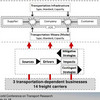
Tag Archives: sparse transportation networks

How Norwegian freight carriers handle disruptions
Remote Logistics
Bad locations = bad logistics?
Supply Chain Disruptions – Does Location Matter?
Norwegian roads are slooooow…
TRB 2009 – are you going there, too?
Sparse transportation networks – a nightmare
Overcoming locational disadvantage
Sparse transportation networks and disruptions
The vulnerability of the transportation network as part of the supply chain is of particular interest in countries or regions with sparsely populated areas, and hence, a sparse transportation network. Typically traits of such regions are few transportation mode options and/or few transportation link options for each transportation mode, for example maybe only one railway line and two roads, no port, no airport. It should not come as a surprise then that the nature of sparse transportation networks, and thus sparse supply chains, makes them vulnerable to many different kinds of internal and external risks.
Norwegian roads are dangerous!
Accessibility Index – Transport Network Vulnerability
Supply Chain Disruptions – Does location matter?
In regions or countries with sparse transportation networks or few transportation mode choices the structure or design of the supply chain, along with the organization and preparedness become important factors in determining if a company has an favorable or a unfavorable location. In locations with a sparse transportation network there are maybe not so many options as to setting up the supply chain; the supply chain is in fact constrained by a certain physical location. Does this make it more susceptible to disruptions?